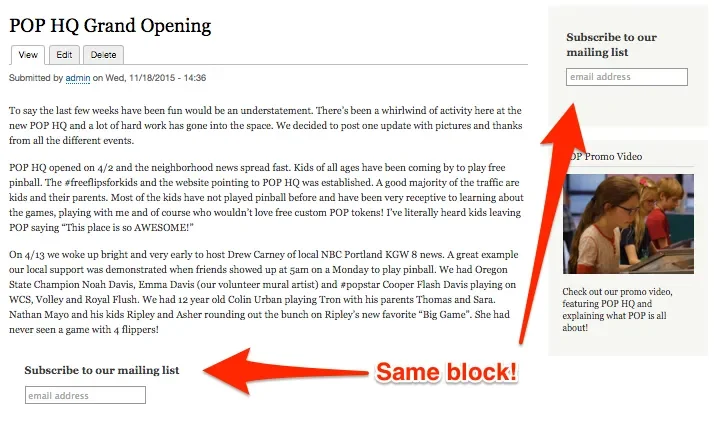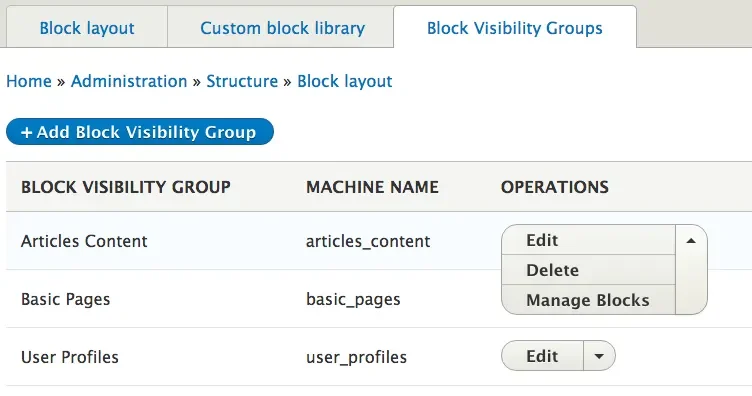Outside my Drupal and Lullabot life, I help my girlfriend Nicole run a non-profit called Pinball Outreach Project, POP for short. POP brings pinball to kids by taking games to children’s hospitals, as well as working with organizations like Children’s Cancer Association, Girls Make Games, and Big Brothers Big Sisters to bring pinball to their events or host kids at our pinball location here in Portland.
The POP website was built in Wordpress and has served us well for three years, but as we have become more active and our needs have expanded, it has started to show its age. There are several parts of the site that are difficult to update because they are hardcoded in templates, it relies on some paid components to keep running, and the theme hides a lot of basic functionality that it would be nice to have access to. On the plus side, it is a simple clean design that is fully responsive, so navigating the site is pretty easy.
We wanted to build a new site that kept the design elements we liked but expanded the functionality to make the site easier to update and more flexible to allow for future growth and needs. Given my expertise, Drupal seemed like the obvious choice, and given where we're at in the release cycle I thought, "Why not do it in Drupal 8?" It would give me some real hands-on experience, and hopefully, we'll end up with a modern tool that can help us grow into the future.
Thus began our odyssey, a new website for a small non-profit in Drupal 8. In the coming weeks, I will outline this process from the standpoint of a Drupal 7 expert experiencing a real site build with D8 for the first time. While it is true that I have more D8 experience than many due to my role as the lead of the Configuration Management Initiative, that experience is a couple years old and almost entirely involved backend code and architecture. The site building and theming changes are completely new to me, and in many cases, I don't know what I don't know. In this way, I feel I am like many of you reading this who are also about to embark on this journey. Let’s discover the new stuff in Drupal 8 together, and we can all learn something along the way.
About the new site
Before we get into the build, let’s look into what we're building. The POP site has several high priority functions that we need to address:
- Provide information about the organization and its mission.
- Publicize upcoming events, as well as wrapup information and photos about events that have already happened.
- Provide news about other POP happenings.
- Provide information related to POP HQ, our location here in Portland (hours, league, party rental, etc.)
- Allow users to get information about our current needs and donate.
- Enable users to interact with us through social media and our newsletter.
For better or worse, we don't have a ton of design or UX resources at hand, so our goal is to shoot for a simple information architecture and wrap a super clean theme around it. We're going to start with some very basic wireframes, prototype the site, then head into the design/theming phase. Now I know what you're thinking, if a client came to me with this plan, I would scoff and laugh too. Nevertheless, remember that most clients are also extremely particular about their design, UX, and branding. From our perspective, we are far more interested in getting the functionality we need in place and the information we have up front to our site users. Beyond that, a theme that is reasonably equivalent to what we have now is perfectly fine. We are going in knowing exactly what our limitations and expertise are, and being willing to work within those constraints.
The one thing we want from a new design, that we don't have now, is to put our imagery much more front and center. Pinball is a hobby that has some fantastic visuals, and our events pair that up with kids having fun which makes it all the more appealing. We should find a way to put that in front of people as much as possible.
Beyond that, I picture a pretty straightforward site with about a half dozen of your usual content types (page, article, event, promo block, maybe images and galleries.) The site will be simple enough that I was figuring we could build it with Context to manage block placement and an assortment of Views. Add on a few custom blocks and I figured we would be most of the way there. So let’s see how that played out from day one.
Getting started
Getting Drupal 8 installed was not much different than it was in D7, so I won't spend a ton of time dwelling on that (although it was really nice that I could let the installer create my new database for me, thanks Angie!) If you'd like to read more about installation, I recommend Karen Stevenson's recent article on using Composer to install D8.
The first thing I wanted to check once I got Drupal installed was the state of a few contributed modules, and first on that list was Context, as I was planning on having it serve as the main organizational paradigm for the site. I was pretty surprised to see that a D8 port of Context had not even been started, much less in any usable state. I mentioned this on IRC, and someone said that perhaps the core block enhancements in D8 might meet my needs. Say what? Blocks are actually useful now? Hard to believe, but it is true! There are two main enhancements to blocks in D8 that make them super-powered over D7.
Instancing
Let’s say you have a block, and you want to place it in the sidebar in some contexts, and in the triptych in others. A huge problem in past versions of Drupal is that blocks can only be placed in one region per theme. If you want it in two different regions based on different visibility rules, you have to have two blocks. This limitation alone was a huge driver towards Context for many sites. In D8 blocks can be placed as many times as needed! This addition is a huge step up for blocks.
Blocks are entities
Blocks are full-blown entities in D8. This means they have a ton of functionality they never had before.
Just like with content types, blocks also now have custom types. This means you can set up unique blocks with their own sets of fields, and use them for their own specific purposes. We can have the promo block type described above, but then also have one we use like a nodequeue, and then one that is just a big HTML block which we can use to embed something like a MailChimp signup form or other non-fielded content.
Blocks also now have fields. On the surface, this can sound like a case of over-engineering something that is supposed to be simple, but this actually has enormous utility. For instance, one of the things we often find ourselves doing on modern sites is creating a "Promo" content type which is not much more than a title, text, a photo and a link promoting another piece of content.
We can now do that with core blocks by creating a Promo block type and creating placement rules around where it appears. Since we also have instancing, we could have it in the sidebar on some content, in the content area of other content, and in the footer on the homepage.
Fields on blocks can also allow us to replicate some simple nodequeue-like behaviors. Create a block with a multi-instance entity reference field and a title. You can now choose a set of entities for the block to display and place that block using the normal core block placement rules. This could be expanded on in a lot of different ways, the combination of block placement with fields provides a ton of flexibility which we never had before.
Finally, having fields means that you can have blocks with efficiently “chunked” data, rather than just a big text field you dump HTML into. This has enormous implications for accessibility and having a more robust device-independent layout.
Block Visibility Groups
While it’s not a part of core, the Block Visibility Groups module can help expand and organize the core blocks functionality even further. Block Visibility Groups adds the concept of a group of blocks, which basically act as if they were one block. Say you need three blocks in the sidebar, but all of them appear on the same path, and only to authenticated users. You can add them all to the visibility group, and then apply the rules to the group. Down the road, if those rules change, you can change them in one place. It also organizes the blocks page better, limiting the number of individual entries you have to deal with.
Conclusion
Fields and instancing, when combined with the existing block visibility rules and contrib modules like Block Visibility Groups, make blocks in D8 a killer feature. Based on my pretty basic needs, I no longer need to worry about whether or not Context is ported because I'm pretty sure I can do everything I want with core. On top of all that, all my config for these blocks is now deployable through the Configuration Management System, which will be the topic of our next article.
Special thanks go out to larowlan, timplunkett, and eclipsegc for pushing through the major patches that made blocks become super useful in Drupal 8!



